[Editor’s note: this interview appeared in its original Italian version on 14 November 2021 in the influential journal AboutArtOnline.com, of which Pietro Di Loreto is the Director. We warmly thank dott. Di Loreto and prof.ssa Raffaella Morselli for their kindness and generosity in letting us translate and republish this important piece on the sale by judicial auction of the Villa Aurora, which was set into motion in September 2021 but came to the attention of the Italian and world press only in mid-October. ADBL editor T. Corey Brennan translated the piece and added images and their captions; errors in these regards are solely due to him.]
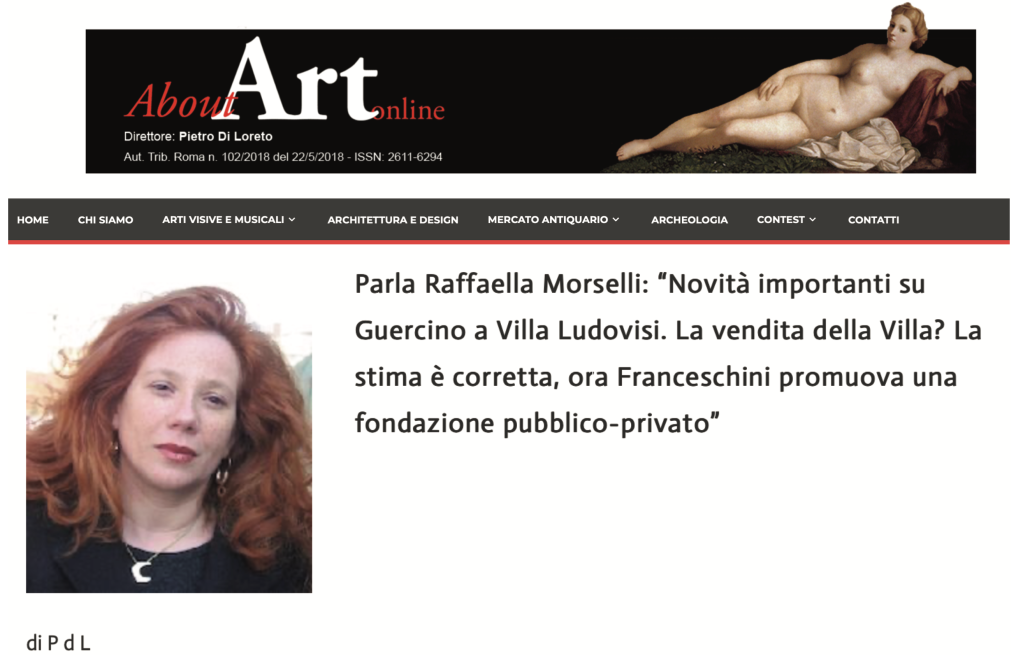
Raffaella Morselli is full Professor of History of Modern Art at the University of Teramo; her publications are numerous, in particular on painting and Emilian artists; she has curated exhibitions and has participated in panels and conferences in Italy and abroad; she has also held positions in various foreign universities. We met Professoressa Morselli to get her point of view on the issue of the sale of the Villa Ludovisi [i.e., the Casino Aurora of the ex-Villa Ludovisi in Rome], since she directly participated in the project directed by Professoressa Barbara Ghelfi on Guercino’s frescoes in the Casino, and she also has followed the story of the estimate of the painted portions of the complex made by Professor Alessandro Zuccari—and judged by some to be excessively high. During our conversation there emerged important observations on these topics, but above all very significant news on the technique of the painter from Cento which would allow us to rewrite an important page in the history of art. Interviewing is the Director of AboutArt online, Pietro di Loreto.
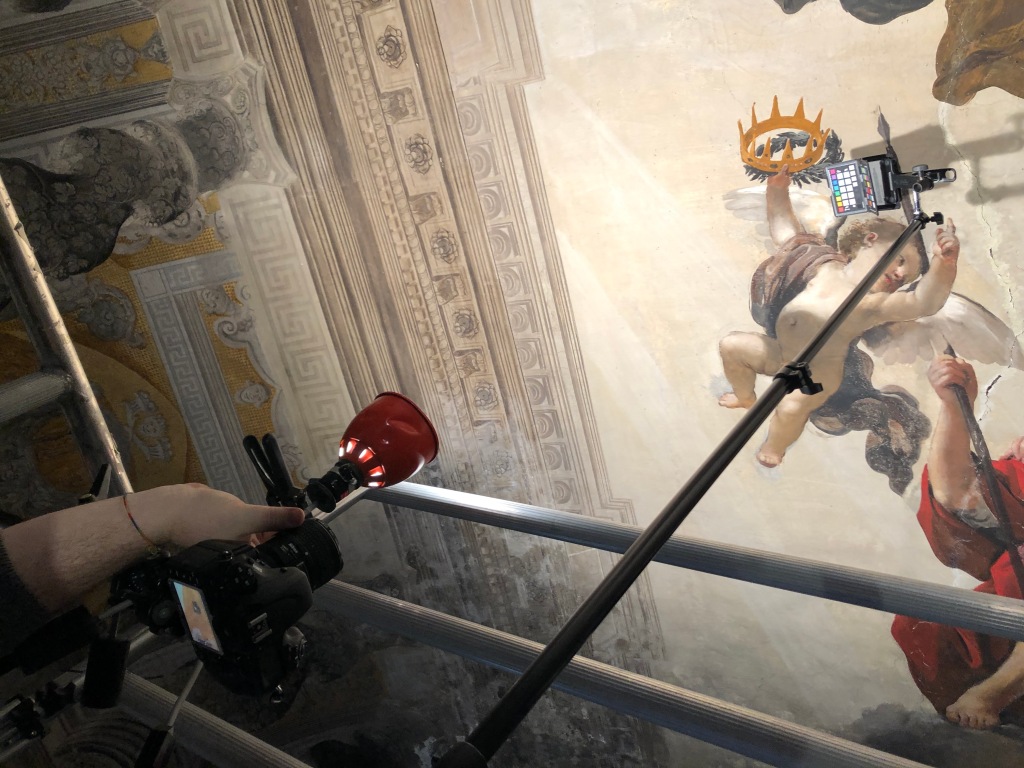
PdL: Professoressa Morselli, so you were able to see Guercino’s frescoes up close? Before we start a conversation focused precisely on the sale of Villa Ludovisi, I would like to know what you have observed and if you have any news to tell.
RM: In fact, I keep up with the Guercino Beyond Color project of the University of Bologna, directed by Barbara Ghelfi, and since 2019 I have had the opportunity to personally verify the state of conservation of the wall paintings. But before answering, let me tell you about the excellent relationship established with Prince Nicolò‘s widow, Princess Rita Boncompagni Ludovisi, a person of exquisite kindness who knows perfectly the importance of the villa and the patrimony of its murals. She is an intelligent and passionate woman and for this reason her main concern is to maintain the accessibility of the property, with the awareness that to do this a really important financial effort is required.
PdL: One can therefore say that the potential buyer will have to think carefully about how much can be committed to the purchase. But that is a theme that I would like to take up later, if you agree. Because I am first of all interested in knowing what you have been able to observe while you were in front of the mural paintings of Guercino, if your investigations are finished, and if they will be published.
RM: We will publish the results of our research in a special issue of the journal Storia dell’Arte, which I am co-editing with Daniele Benati and Barbara Ghelfi. It is expected to come out in the spring of ’22 and will focus on Guercino and his Aurora. We will also make known what has emerged regarding the relations of the client, i.e., Cardinal Ludovico Ludovisi, with the artist, and we will give particular attention to the results of the diagnostic investigations, which show much that’s new.
PdL: Can you say something beforehand?
RM: For example, that Guercino did not paint in fresco, this is the first news.
PdL: Well, that’s certainly not insignificant.
RM: Indeed, Guercino did not make frescoes. He used a mixed technique, mainly a secco (“dry”) painting. This is what emerges from the analysis conducted by the Diagnostic Laboratory of the Department of Cultural Heritage of the University of Bologna, communicated in the context of a recent conference dedicated to Pope Gregory XV Ludovisi, organized by Rutgers University (New Jersey) in collaboration with Kutztown University (Pennsylvania). Another important takeaway: the artist intervenes on the architectural structures painted by Agostino Tassi, which therefore had already been created at the time of his intervention. Keep in mind that Guercino himself was practically at home with the Ludovisi family. And he intervenes when the architectural composition was already ready, so much so that in the detail where the arch opens, it is clear that it was covered by the Guercino painting, and that architecture emerges below. It must be said that Tassi was at the time the “main attendant” of the house, that is, he had the keys in hand to access the rooms and the works of art.
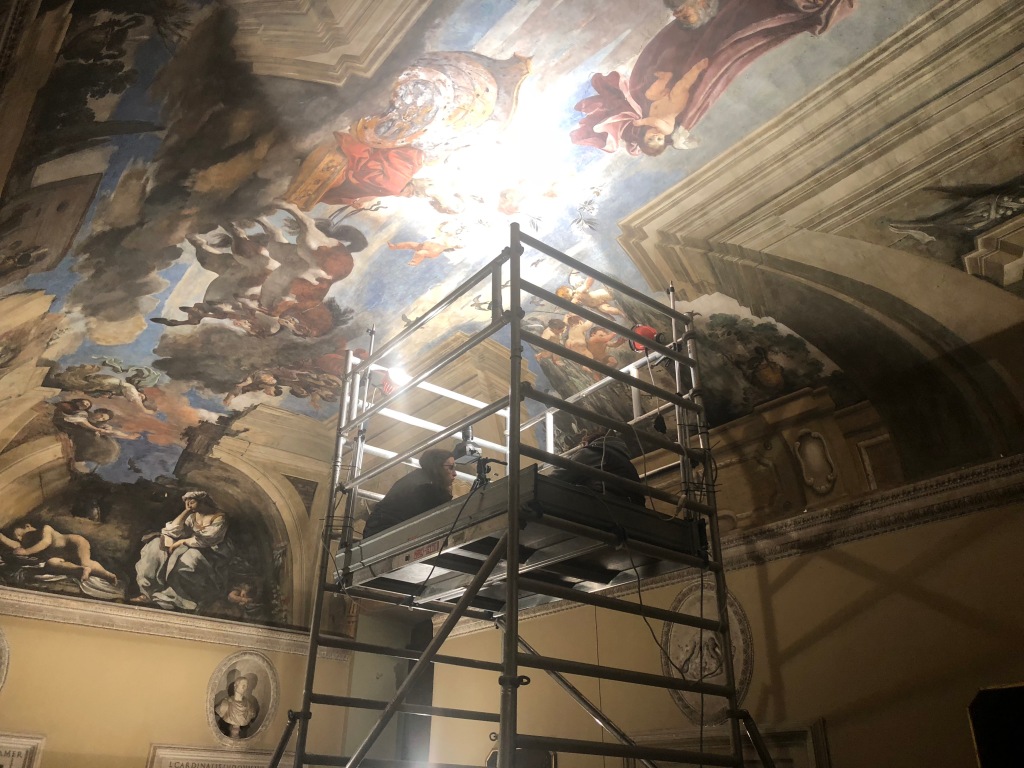
PdL: Were you able to reconstruct the chronological order of work?
RM: Granted, we are still studying and reflecting on the results of the investigations we carried out, but still I can advance my idea, namely that Guercino started with the Camera dei Paesaggi. I digress to emphasize that already in this first room we are face-to-face with sensational masterpieces. In fact, in addition to Guercino, Domenichino, Brill and Viola worked on it. I believe that afterward the Aurora was painted, and lastly the Fama on the upper floor. From the images taken by the staff of the Diagnostic Laboratory of the University of Bologna, it is very clear how the artist from Cento works perfectly with black chalk to define the contours of the figures. These are exceptional paintings that in some cases show some repainting, as in the blue of the Aurora sky.
PdL: Have you been able to ascertain the epoch or epochs of the repainting?
RM: They probably date back to different eras. To be sure, we have found a report preserved in the Vatican Secret Archives, dated in the 1930s by Pico Cellini, which is the only one that is certain in this respect.
PdL: Among the artists involved there was also a certain Caravaggio.
RM: Sure, and his painting is located in a small room on the first floor, in an area of the building that was transformed around the 1950s. Adjacent to this ‘camerino’ is an apartment which is now completely empty and mostly with a false ceiling. Furthermore, from some surveys carried out, it appears that in the Casino there are other frescoes from the eighteenth century; in short, the place is truly unique, an extraordinary mural art gallery with decorations ranging from the sixteenth to the nineteenth century.
PdL: Previously you were talking about the role of absolute protagonist played by Agostino Tassi in the management of works of art for the Ludovisi. Can we then think that Tassi ordered Guercino to undertake those enterprises you were talking about and that everyone appreciates?
RM: No, I don’t think so. As I said Guercino was practically at home with the Ludovisi and everything suggests that they called him directly. What should be emphasized is that he came from a provincial town, from Cento, where he had a flourishing shop. And he finds himself the protagonist of a very important project with a typically Roman modus operandi, that is quite distant from what he was used to.
PdL: And what could this mean? It strikes me as a theme to be explored.
RM: We have to try to imagine the state of mind of a young artist who finds himself faced with a completely different reality and way of working, which he does not know. We know that he lived in Rome with Guido Cagnacci, with the mosaicist Marcello Provenzale, and breaks into a world that in these years is full of building projects of exceptional importance. These are for him a total novelty, precisely because there is a foreman and other workers who collaborate together. It is a completely new dimension, which produces the results we are evaluating, thanks also to the total availability of Princess Rita Boncompagni Ludovisi, who, I like to repeat, has always shown a sincere interest in the protection of the Ludovisi heritage.
PdL: Can you tell us more about this?
RM: What I know I learned from the press, but as I said before, it is necessary to emphasize the attention shown by the Princess—of which my colleagues Barbara Ghelfi and David M. Stone and I have been good witnesses. The hospitality of Rita Boncompagni Ludovisi was truly exquisite and allowed us to study with the necessary calm the extraordinary works of art preserved in her residence.
PdL: To go back to the theme of the paintings of the early Guercino. From the way you described it, it seems to me that a figure has been delineated that does not completely match with what specialist criticism has established to date. Is that so?
RM: The theme deserves further study. Guercino, as I said, arrives in Rome as a provincial unaccustomed to the logic of the artistically most important city in the world. We can imagine his astonishment when he raises his eyes on the monuments that surround him, on a reality so distant from his, that he approaches for the first time. I underline the fact that Guercino does not come from Bologna, the second city of the Papal State, but rather from Cento, with a completely Ferrara-centric artistic background. In fact, in the Aurora you can clearly see the quotations from Dosso Dossi, almost literal suggestions—just think of the beautiful white wildflowers scattered by the goddess. This is not a Roman world, but a fairy-tale dimension of Emilian derivation, which impacts the reality of a capital in great turmoil in those times. Guercino places himself at the service of Ludovico Ludovisi the cardinal nephew, the most powerful personality of the time after the Pope, moreover in a wonderful place. Today we see only the last portion of that extraordinary complex that were the Villa and the Casino, with the wonderful gardens praised by Stendhal and Goethe. In short, Guercino enters a completely different place from those he had associated with up to that moment.
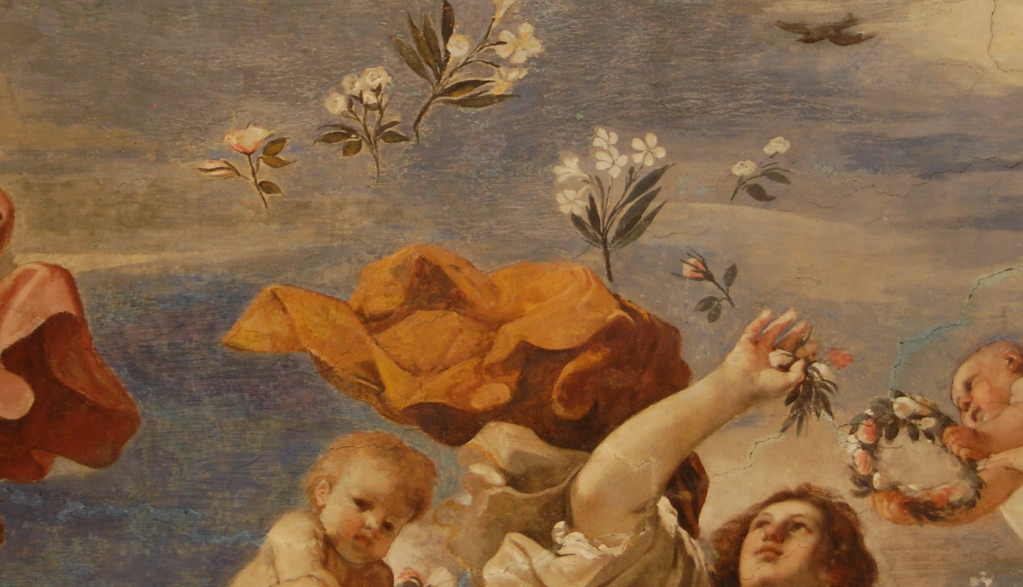
PdL: You insist on this characteristic, let’s say “provincial”, of the artist who arrives in Rome. But I ask you: how much may he have been contaminated by the Roman environment? And on the other hand: how much may he have artistically influenced that environment, thinking about the fact that in those years, at the beginning of the third decade of the seventeenth century, the Caravaggesque climate was already in the process of dying out?
RM: Guercino always has his own typical characteristic, a sort of very accentuated ‘verve’ that makes it original in that Roman context of great works and changes in artistic languages. Not surprisingly, in the opinion of the critics, this is his best moment. They are the most beautiful years, the years of the ‘gran macchia’, of the intense blue, which Roberto Longhi brilliantly describes as “stormy, dappled, brusque“, a judgment which I think over at length. Afterward, it is obvious that the painter looks around and cannot fail to remain indifferent to what Guido Reni created for example in his Aurora for the Borghese. And of course he looks also at Caravaggio, if only because he worked a few meters from the masterpiece of the Lombard genius that it is Jupiter, Neptune and Pluto. However, the Cento painter maintains this moody feeling, “stormy” as Longhi said, which does not belong to others and which over time has had great admirers.
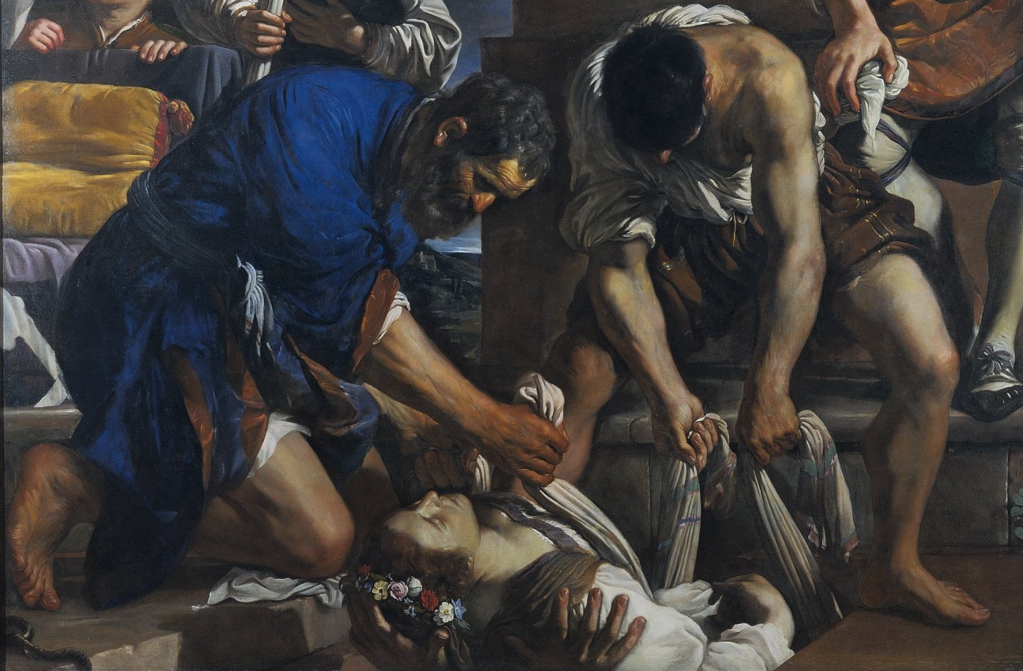
PdL: One of the greatest achievements, an absolute masterpiece for art history, is the Burial of Santa Petronilla.
RM: The Burial of Santa Petronilla, today in the Capitoline Museums, is an extraordinary invention, and it deserves a separate discussion. Just look at the position of the saint: it is not clear if she is hoisted or deposited by those hands in the foreground, that support or vice versa lower the body. And then there is that crown of flowers, the wild flowers of the Emilian countryside that we find in theAurora, which Guercino details as if he were looking at a field of buttercups just outside his home, on the banks of the Reno river.
PdL: So, in your opinion, does his background, i.e., the Cento training, resist and artistically assert itself even in Rome, even in the face of different experiences and [artistic] languages?
RM: In my opinion, his Cento training resists for a long time. Guercino always has Dosso in his mind and in his eyes. On the other hand, one realizes by closely observing the painting of the Casino Ludovisi how his painting breaks through—and not only in a figurative sense, because it actually literally breaks the limits of Tassi’s architecture. The painter finds it ready and decides to break it, as if to say that the force of the Aurora chariot overcomes all limits and knocks down every obstacle.
PdL: Do you think there was such a perception at that time? I mean, was it possible to identify these meanings behind the paintings?
RM: The discussion also concerns how the paintings were viewed, because with regard to the small alchemical room, for example, many things still need to be clarified, starting with where the access was located. We don’t know today, but on the side of the spiral staircase there is a door: where does it lead? It is not known, it would be necessary to open it, to see what lies beyond. Personally, during this research I have often been in Caravaggio’s Camerino. There you can see an oval, whitewashed together with the walls, often with colored elevations that reveal a green panel, in copper. What is it? It would be good to clean it completely, to think about whether it could be part of the necessary apparatus for the alchemical fire. But who can do it today?
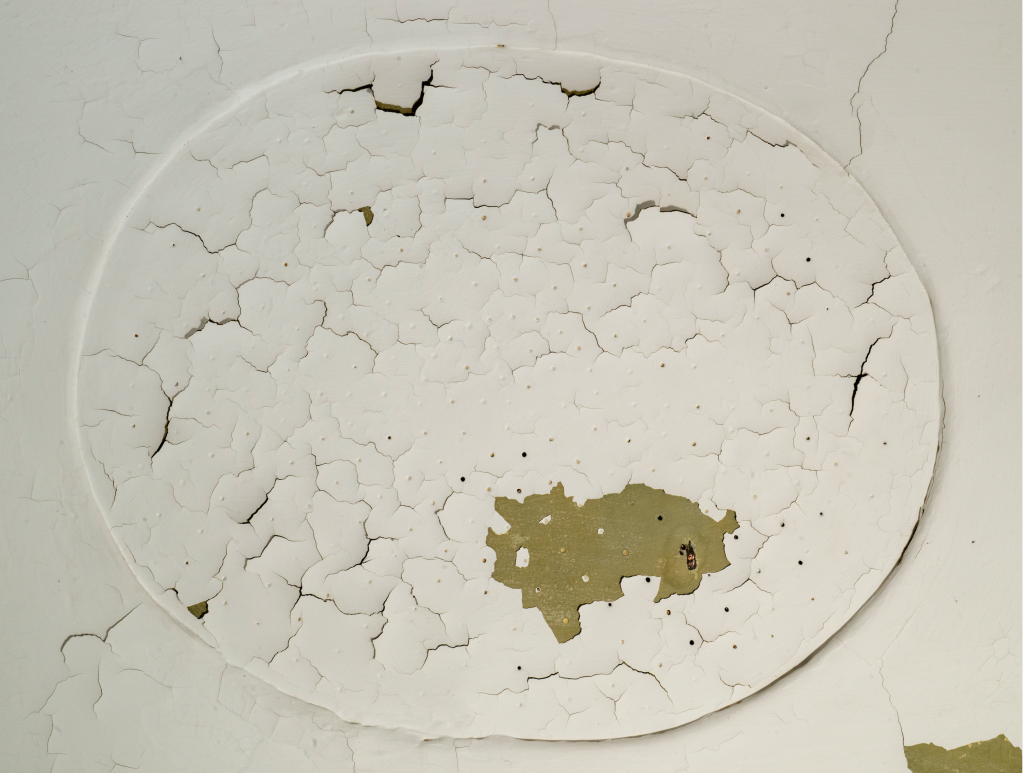
PdL: It seems to me that we are facing the problem of problems. Who will buy this property? And whoever it is, will they be willing to do further research, new surveys, other verifications?
RM: It’s a really big problem. We do not know how the story of the sale will end. But it is clear that for the paintings there is a need to provide extraordinary maintenance. Though the painting by Caravaggio shows no problems after the restoration a few years ago, on the contrary the paintings by Guercino are in need of care.
PdL: I would ask you now to pronounce on a topic that is causing discussion. You will certainly have read the positions taken also in the About Art “special” regarding the estimate that many consider too high and that would sideline the Italian state if it intends to proceed with the purchase.
RM: In my opinion, we are faced not so much with a diatribe but with a sort of collective reasoning in which everyone expresses their point of view. It is necessary to start from a fact, namely that a magistrate asked Professor Alessandro Zuccari to appraise the murals of the Ludovisi Casino, when it was not yet known how this appraisal would be used. No one knew that the asset would go up for auction.
PdL: I’m stopping you, because this is new. It seems important to me, if not really decisive.
RM: I can confirm it. When the judge requested Professor Zuccari for a survey, it was a matter of valuation and no one knew how the matter would go, i.e., that there would be a public auction. Alessandro Zuccari was commissioned to offer estimates for the paintings and objects in the Villa. I must tell you that I read with great attention the article by the lawyer Gloria Gatti which expresses a point of view that is certainly appropriate. However she assumes that the asset necessarily had to be auctioned while, as I said, it was not at all clear that this would happen. At least this idea had not been proposed to the experts. Furthermore, attorney Gatti reports a legal decision concerning the sale of Tiepolo’s frescoes at Villa Barbarigo. But here, in the Casino Ludovisi, we are faced with a different case. It is a building that has undergone various stratifications and for this reason it is absolutely unique, a precious receptacle of works of art of various kinds dating from the sixteenth to the nineteenth century, which belonged to several individuals, from Cardinal Del Monte to the Ludovisi. It was necessary to take account of all this on appraising it.
PdL: However, as I said to you, there is much criticism concerning the exorbitant price—I say this for the sake of information, because for me personally the estimate is even low. That arose from a criterion based on the calculation of the square meters of the paintings on the wall, as well as on the estimation for a painting attributed with much resistance to Caravaggio, about which there was enormous hype, but then it disappeared from circulation.
RM: The fact is that when a magistrate instructs you to evaluate the frescoes, or rather the paintings on the wall, and you decide to accept the assignment, you must find the evaluation indexes. In the case of the Ludovisi, you must indicate it for the works of two geniuses of painting like Caravaggio and Guercino. There are two alternatives: either, as attorney [Fabrizio] Lemme wrote in your journal, you decide that they are invaluable assets, or you take note of the judge’s request and find points of reference that allow you to develop your estimate. Among other things, the question of invaluableness was immediately posed by Professor Zuccari, who pointed this out to the magistate, as he stated in the report. If you read the appraisal, the fundamental parameter adopted was consideration of the insurance value on autographed works of Caravaggio. An easel work was estimated at 150 million while meanwhile an altarpiece 200 million euros. How could he have underestimated Merisi’s only oil painting on a wall in the presence of these already accepted documents?
PdL: And right here was the origin of the discussions.
RM: I understand, but I ask you: what are the indexes for drawing up university rankings? With which indexes ought one establish which university is better than another? A few days ago the rankings of the best Italian high schools appeared in the press: according to which indexes were they drawn up? Certainly there are some individuals who have not been satisfied and have considered the evaluation criteria not suitable; it is always so. These are choices that must be declared and homologous. Provided that these two principles are respected, by changing the indices the results vary accordingly.
PdL: But has the problem arisen that in this way the evaluation of the complex reaches the point of effectively excluding the possibility that the Italian state can buy it?
RM: Of course the problem has arisen. But the judge felt that it was necessary to make an assessment that did not underestimate the property and that would enhance it with an evaluation that was at least congruous. The judge ensures that in this way, contrary to what some believe, the property is caused to be safeguarded from any speculative interventions, which a low valuation could trigger. And then try to think of the opposite case: think if Professor Alessandro Zuccari had given a lower figure as an estimate instead of the 471 million known. The property would have had a huge market, attracting the interest of various buyers not all interested in its safeguard and protection.
PdL: It is also true that the asset is protected and subject to constraints, and this is already in itself a decisive aspect.
RM: Add the fact that not only is the property constrained and protected, but whoever intends to buy it must be aware that there is work of consolidation and conservation which, with the exception of Caravaggio’s painting, affects large parts of the entire complex.
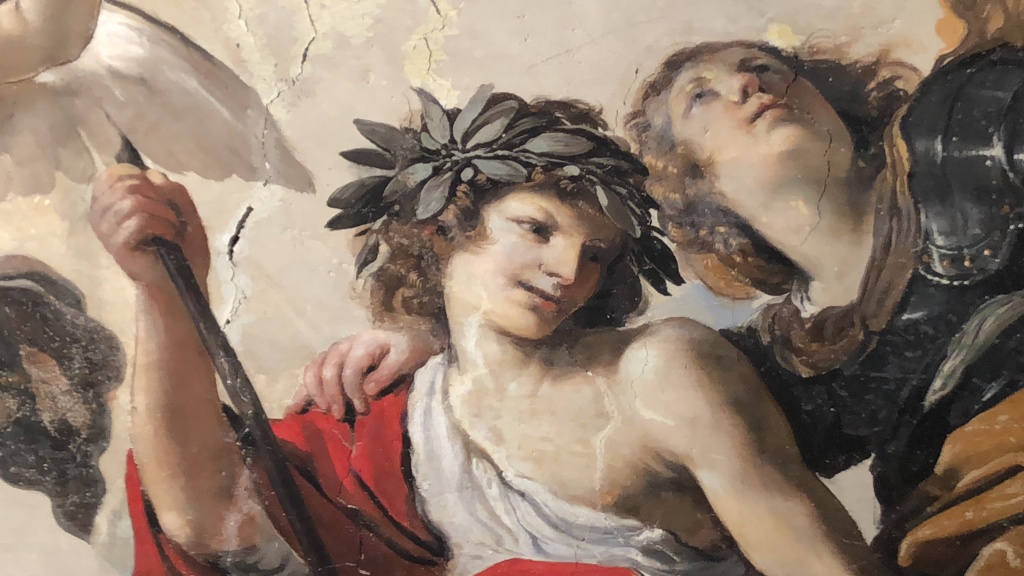
PdL: Do you agree with Dr. Galli and Vittorio Sgarbi according to which a much lower estimate, around 20-25 million euros, would allow the state to enforce the pre-emption?
RM: I have no tools of divination to imagine this. Do you think it could be a fitting and objective figure, 20-25 million for a unique property? In my opinion, the state should promote a public-private consortium to acquire an asset that has no equal. It is paradoxical that there is controversy over the decisions of a magistrate who is trying to save an asset that in any case—and attorney Lemme clearly wrote this— remains private and constrained. In my opinion the high evaluation estimated by Professor Zuccari is not only correct but it is a protection against the possibility that the Casino can be sold off for a lower amount. In this way, it was placed at the center of everyone’s attention, making us open our eyes to its uniqueness.
PdL: But if there arrives the classic moneybags who buys it…do you think such a person would be really interested in improvements, conservation, in continuing the research? Aren’t you afraid that in this case you, as a scholar, would risk not setting foot in it again?
RM: It is a fact that we have to think about, because I have some concern for how many constraints there are. Perhaps the Ministry should think of a new formula relating to the regulation of constraints, in the sense of inserting a sort of mandate on protection and investment, but it is a matter for the lawyers Galli and Lemme who could clarify our ideas in this regard. Of course, if I think of that copper I was talking about, for one thing, I would like you to go ahead and try to find out what it is, while perhaps for a private individual this might be of little interest. Obviously, from my point of view as a scholar, the intervention of the Ministry would be desirable, perhaps in agreement with the new owner because it is necessary that what has survived of this complex be made welcoming and accessible.
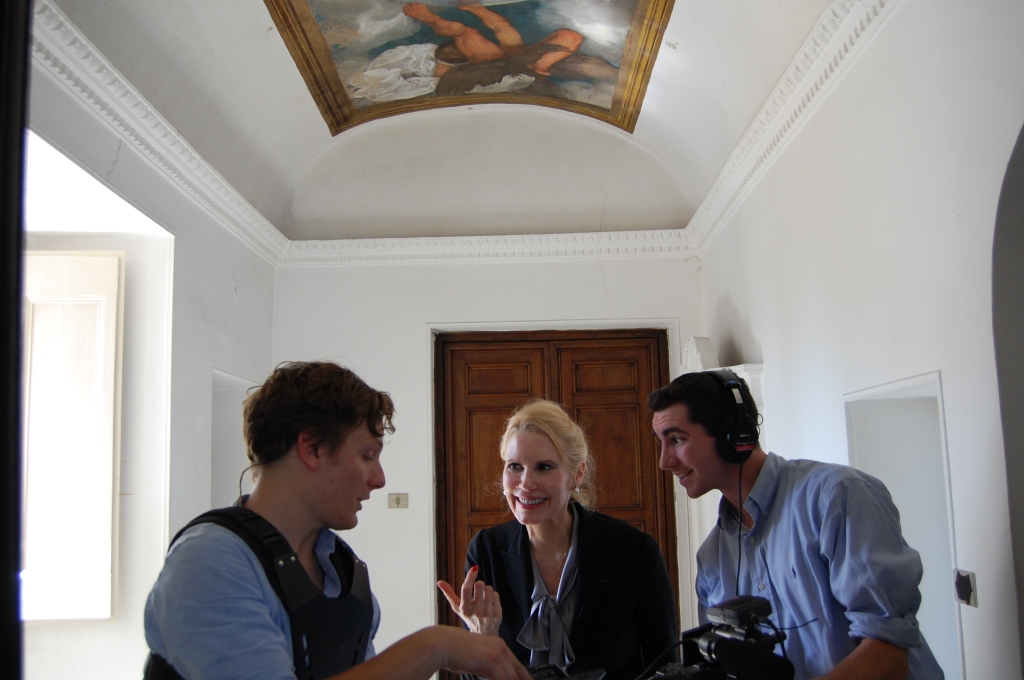
PdL: This is why we talk about it a lot.
RM: It’s true, there is a lot of talk about it. But few really know what they’re talking about, because few have been to this sort of seventeenth-century Sistine Chapel.
PdL: But, in your opinion, why are these masterpieces spoken of when problems arise, or unforeseen events occur, and then everything goes back to silence?
RM: It is a question that affects the country’s cultural policy that we can compare to a chain. When some link is broken, then the question comes to the fore. Furthermore, it must be noted that there is no trust between private individuals and the state, and here one ought to intervene with new mechanisms.
PdL: Now I’ll ask you a somewhat provocative question. You are of Po Valley origin and training, and it is clear that you love Guercino and Emilian and Ferrarese art very much. So I’ll ask you: if there hadn’t been a mural painting, the only one, by Caravaggio in this building, would there have been all this attention?
RM: Certainly not, so much so that in the articles of the commentators Caravaggio is mentioned a lot, and Guercino far less. It is evident that the “case” has jumped to the fore thanks to Caravaggio, if I may say so; afterwards a wonderful Caravaggio is under the eyes of all, with that sphere that looks like a huge soap bubble. The paradox is that in the photo it looks like a mammoth painting and it is not, while on the contrary Guercino bursts out and is immense.
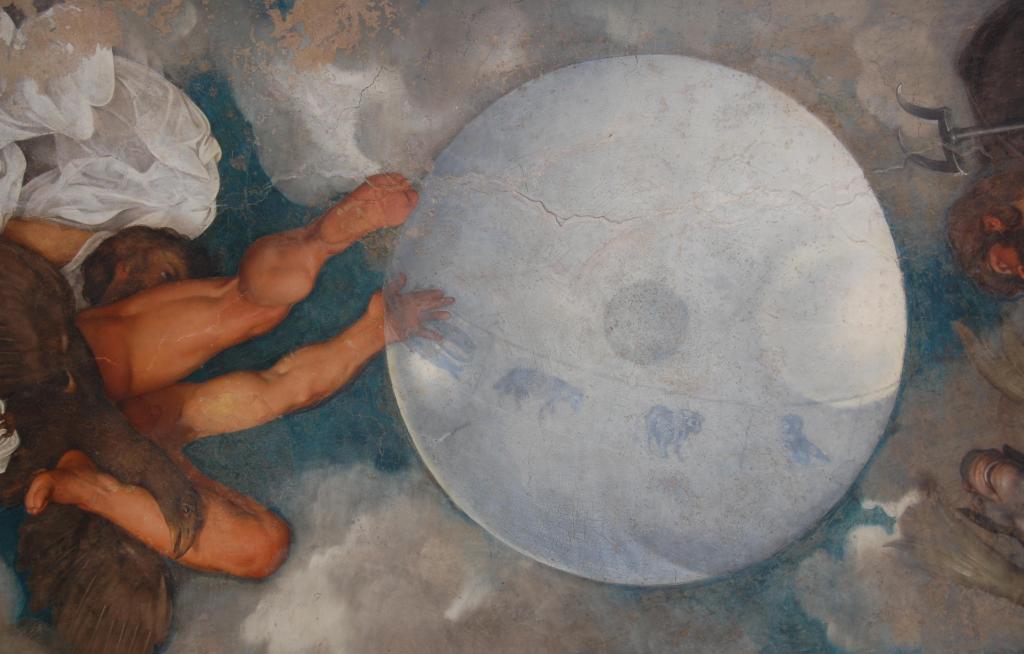
PdL: A last question, if you were to make an appeal to [Italian] Minister [of Culture Dario] Franceschini, what would you say?
RM: I would ask him to reason, with all the administrative and legal tools, to allow the best accessibility of this property which is privately owned. How can it be protected if it is not possible to acquire it as a public property? This is also a topic to discuss and I believe that the Ministry should reflect on it. It is a question to be answered through new systems of operation, so that anyone who purchases the asset is obliged to take care of it and to speak with those in charge of protecting and enhancing it through mutual trust.
Pietro Di Loreto, Rome 14 November 2021
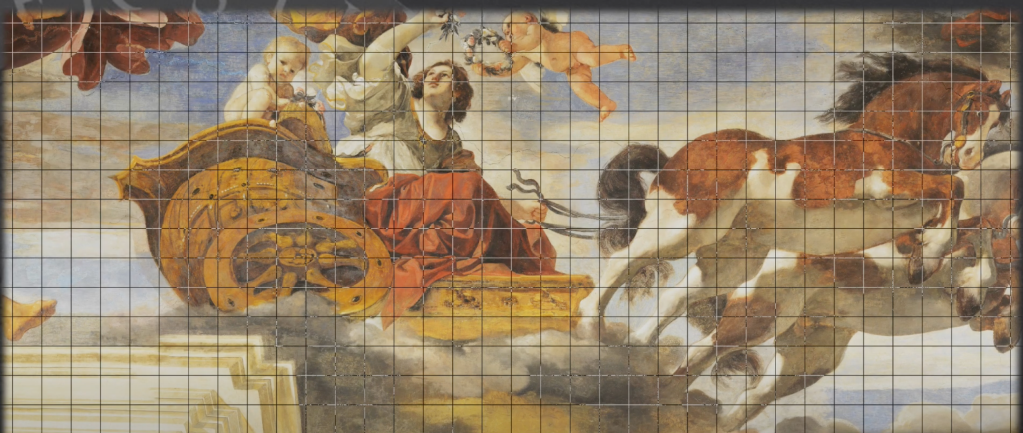
Beautifully done e displayed!
Sent from my iPad Rita Boncompagni Ludovisi
>
Absolutely beautiful paintings! Such a work of art..Having a property for that long in the family has tons of history and yet mystery…If house could talk..what would they say i wonder..lol